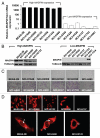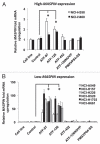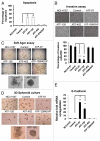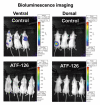Reactivation of MASPIN in non-small cell lung carcinoma (NSCLC) cells by artificial transcription factors (ATFs)
- PMID: 20948306
- PMCID: PMC3278788
- DOI: 10.4161/epi.6.2.13700
Reactivation of MASPIN in non-small cell lung carcinoma (NSCLC) cells by artificial transcription factors (ATFs)
Abstract
Tumor suppressor genes have antiproliferative and antimetastatic functions, and thus, they negatively affect tumor progression. Reactivating specific tumor suppressor genes would offer an important therapeutic strategy to block tumor progression. Mammary Serine Protease Inhibitor (MASPIN) is a tumor suppressor gene that is not mutated or rearranged in tumor cells, but is silenced during metastatic progression by transcriptional and epigenetic mechanisms. In this work, we have investigated the ability of Artificial Transcription Factors (ATFs) to reactivate MASPIN expression and to reduce tumor growth and metastatic dissemination in Non-Small Cell Lung Carcinoma (NSCLC) cell lines carrying a hypermethylated MASPIN promoter. We found that the ATFs linked to transactivator domains were able to demethylate the MASPIN promoter. Consistently, we observed that co-treatment of ATF-transduced cells with methyltransferase inhibitors enhanced MASPIN expression as well as induction of tumor cell apoptosis. In addition to tumor suppressive functions, restoration of endogenous MASPIN expression was accompanied by inhibition of metastatic dissemination in nude mice. ATF-mediated reactivation of MASPIN lead to changes in cell motility and to induction of E-CADHERIN. These data suggest that ATFs are able to reprogram aggressive lung tumor cells towards a more epithelial, differentiated phenotype, and thus, represent novel therapeutic agents for metastatic lung cancers.
Figures






References
-
- Zardo G, Fazi F, Travaglini L, Nervi C. Dynamic and reversibility of heterochromatic gene silencing in human disease. Cell Res. 2005;15:679–690. - PubMed
-
- Baylin SB, Ohm JE. Epigenetic gene silencing in cancer—a mechanism for early oncogenic pathway addiction? Nat Rev Cancer. 2006;6:107–116. - PubMed
-
- Zhu S, Wu H, Wu F, Nie D, Sheng S, Mo YY. MicroRNA-21 targets tumor suppressor genes in invasion and metastasis. Cell Res. 2008;18:350–359. - PubMed
-
- Collingwood TN, Urnov FD, Wolffe AP. Nuclear receptors: coactivators, corepressors and chromatin remodeling in the control of transcription. J Mol Endocrinol. 1999;23:255–275. - PubMed
Publication types
MeSH terms
Substances
Grants and funding
LinkOut - more resources
Full Text Sources
Medical
Molecular Biology Databases
